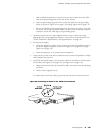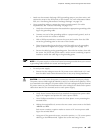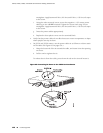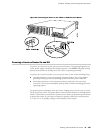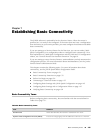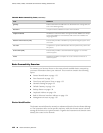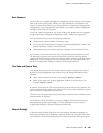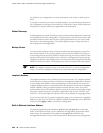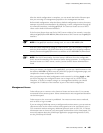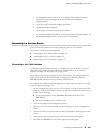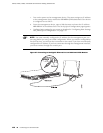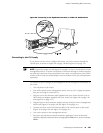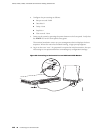Root Password
The root user has complete privileges to configure the Services Router, and manage
files in the router's file system. Initially, the root password is not defined on the
router. To ensure basic security, you must define the root password during initial
configuration. If a root password is not defined, you cannot commit configuration
settings to take effect on the router.
If you use a plain-text password, the router displays the password as an encrypted
string so that users viewing the configuration cannot easily see the password.
The root password must meet the following conditions:
■ The password must be at least 6 characters long.
■ You can include most character classes in a password (alphabetic, numeric, and
special characters), except control characters.
■ Valid passwords must contain at least one change of case or character class.
For Common Criteria environments only, the password must be between 10 and
20 characters long and must include at least three of the five character classes
(uppercase letters, lowercase letters, punctuation marks, numbers, and other special
characters). Control characters are not recommended. For more information, see
the Secure Configuration Guide for Common Criteria and JUNOS-FIPS.
Time Zone and System Time
You define the time zone for the location where you plan to operate the Services
Router by using a designation that consists of the following information for the
location:
■
Name of the continent or ocean—For example, America or Atlantic
■ Name of the major city or other geographic feature in the time zone—For
example, Detroit or Azores
A Network Time Protocol (NTP) server provides accurate time across a network. The
router synchronizes the system time with the NTP server, and periodically accesses
the NTP server to maintain the correct time.
The time zone and system time must be accurate so that the router schedules events
and operations as expected.
For Common Criteria compliance, you must configure NTP to provide accurate
timestamps for system log messages. For more information, see the Secure
Configuration Guide for Common Criteria and JUNOS-FIPS.
Network Settings
A Domain Name System (DNS) server on the network maintains a database for
resolving hostnames and IP addresses. Network devices can query the DNS server
by hostnames rather than IP addresses. The router accesses the DNS servers that
Basic Connectivity Overview ■ 133
Chapter 7: Establishing Basic Connectivity



